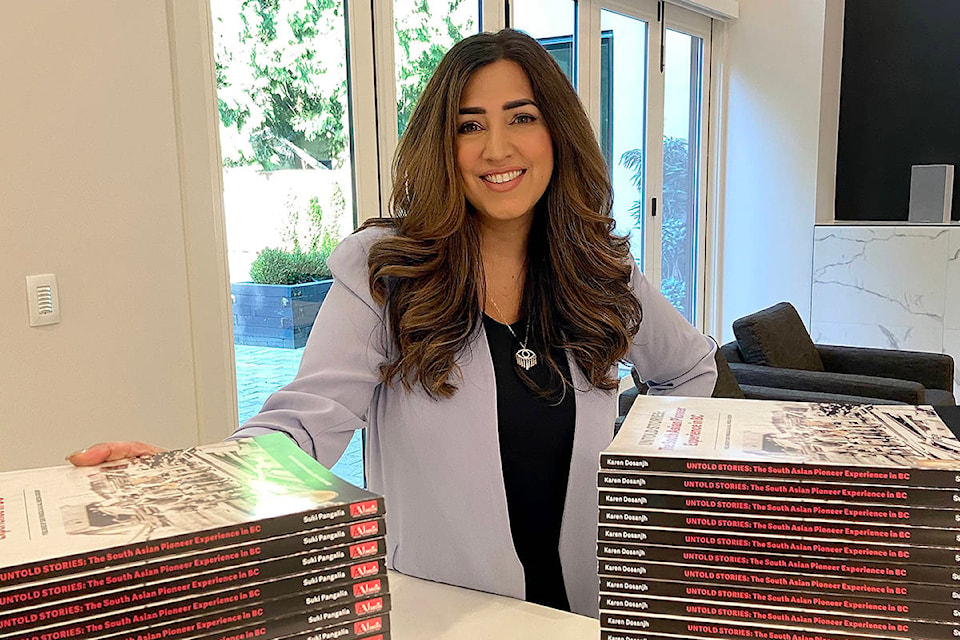A family celebration a century in the making spurred White RockŌĆÖs Karen Dosanjh to undertake an ambitious project ŌĆō documenting the oft-forgotten stories of not just her own ancestors, but those of hundreds of other South Asian families in British Columbia.
In 2006, Dosanjh and her family were celebrating the 100-year anniversary of her grandfatherŌĆÖs journey from Punjab, India to B.C. when she realized the impact that his sacrifices, and those of others like him, had on her family.
ŌĆ£He came to Canada in 1906 and was really instrumental in sponsoring other key members to come here, including my father,ŌĆØ Dosanjh said.
ŌĆ£ThatŌĆÖs where my love of documenting and preserving South Asian history started.ŌĆØ
Her interest piqued, Dosanjh set out to interview and learn from a number of other South Asian pioneer families in B.C. ŌĆō including her father-in-law, whose own father arrived in Canada in 1907.
Those stories were written by Dosanjh and turned into a book, Untold Stories: The South Asian Pioneer Experience in B.C., which was released in the spring, and has since been gaining popularity not just in the South Asian community but beyond ŌĆō including local schools, she noted.
The book has also been endorsed by Prime Minister Justin Trudeau, B.C. Premier John Horgan and CanadaŌĆÖs Minister of Defence, Harjit Sajjan.
Dosanjh has been working with a pair of teachers at L.A. Matheson Secondary ŌĆō who are creating a teacherŌĆÖs guide for the book, to better help teachers fold it into their curriculum ŌĆō as well as the Surrey school districtŌĆÖs Safe Schools program.
We are hard at work putting together the Teacher's Guide for K Karen Dosanjh and @aaj_media_group "Untold Stories: The South Asian Pioneer Experience in BC".
ŌĆö Annie Ohana (@ohana_annie)
ŌĆ£There are a lot of other South Asian pioneer families whose stories havenŌĆÖt been told. So now itŌĆÖs less about it being just for (our family), and more for the entire community,ŌĆØ she said.
ŌĆ£I started working with local schools ŌĆō schools that have a very high South Asian immigrant population ŌĆō because I thought these students could really benefit from learning these stories and learning about the journey that these early settlers faced. ItŌĆÖs about acknowledging it, and then thinking, ŌĆśWhat can we learn from it?ŌĆÖŌĆØ
There is plenty to learn, it turns out.
DosanjhŌĆÖs book covers a wide swath of this provinceŌĆÖs history, and includes a number of stories that even she didnŌĆÖt know beforehand ŌĆō even if many of them are heartbreaking tales of racism and families being split up.
Sections of the book detail the Asiatic Exclusion League, which was formed in B.C. in 1907 with the sole goal of preventing the immigration of Chinese, Japanese and ŌĆ£people of Indian originŌĆØ into Canada ŌĆō and directly led to race riots in both Bellingham and Vancouver ŌĆō as well as the Continuous Journey Regulation, which aimed to keep South Asian immigrants out of the country by prohibiting entry to anyone who did not arrive in Canada directly from their country of origin.
ŌĆ£The first wave of South Asian immigrants were welcomed in to fill labour jobs in the early 1900s, but then in 1908, the door was closed behind them. Women and children were not allowed to migrate ŌĆō they wanted the labourers, but not the labourersŌĆÖ families,ŌĆØ Dosanjh explained.
ŌĆ£So the women werenŌĆÖt allowed to come until 1929. ThatŌĆÖs a big gap, and itŌĆÖs heartbreaking. I know this because it impacted my grandparents.ŌĆØ
ŌĆó READ ALSO:
Untold Stories also describes plenty of personal stories, which were relayed to Dosanjh through the children and grandchildren of those documented in the book.
ŌĆ£The women who arrived here were not allowed to wear their customary clothing publicly ŌĆō it wasnŌĆÖt acceptable in Canadian society back then. And the men were forced to conform by cutting their hair and removing their turbans, which were signs of their Sikh faith,ŌĆØ she said.
ŌĆ£These lessons are important for the youth because it didnŌĆÖt just get like this. ItŌĆÖs been a long journey for South Asian peopleŌĆ” look how far weŌĆÖve come.ŌĆØ
Interviewing people for the book ŌĆō often asking them to dredge up painful family memories ŌĆō wasnŌĆÖt always easy, Dosanjh admitted, referring to the research process as ŌĆ£mining for gold.ŌĆØ
I had to build trust with these familiesŌĆ” These people are entrusting you with their histories, and theyŌĆÖre dusting off things that havenŌĆÖt seen the light of day for years,ŌĆØ she explained.
ŌĆ£It really was quite a journey for me, and I was incredibly moved by their experiences and what they shared with me.
ŌĆ£I have to be honest, it was a dark journey, but it was also enlightening to see how the community and these families have prospered.ŌĆØ
Dosanjh was also quick to note the juxtaposition of that dark, often sad, past with the present ŌĆō notably Diwali, which is to be celebrated this month in Surrey. While COVID-19 protocols may leave the annual celebration looking a little different than in past years ŌĆō during which a portion of the cityŌĆÖs streets have been jam-packed with revellers ŌĆō it is still a very important event on SurreyŌĆÖs calendar.
We get to celebrate our language and our culture, and celebrate vibrantly. That was not the case when these elders first arrived,ŌĆØ she said.
ItŌĆÖs for these reasons that Dosanjh, whose day job is vice-president of marketing for a tech company, decided early on in the process that she did not want to profit personally from the book. All proceeds from sales of Untold Stories have been reinvested into the production process so more copies can be printed, or have been used to create scholarships for Surrey students.
ŌĆśThis was a side project, a passion project that I just felt implored to do. It felt like a calling,ŌĆØ she said.
ŌĆ£But I didnŌĆÖt want to benefit personally from these stories ŌĆō these stories belong to the community.ŌĆØ
editorial@peacearchnews.com
Like us on and follow us on



